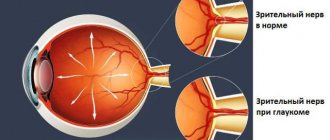The contrast between the TV - the light source - and the surrounding darkness is quite high. The eye constantly tries to adapt to it, which makes it overstrained and tired faster. In the case of a TV, the brightness of the backlit image itself also changes, which gives the eyes additional stress: in the dark the pupil needs to be large, in bright light it needs to be small, and constant changes in brightness force the pupil to change size, which makes the eye quickly get tired.
The problem is not only the darkness, but also the fact that the eye focuses for a long period of time on the same object, remaining in a constantly tense state.
It is generally accepted that regularly watching videos in the dark can seriously and permanently deteriorate your eyesight, and after a night of movie marathon, your eyes will have to be “thrown in the trash.” This story became popular back in the middle of the last century, when televisions just began to appear in the homes of ordinary people, and they built home viewing by analogy with cinema. To be fair, early TVs weren't all that bright, so the difference between watching in the dark and watching with the light on was enormous. But due to the low brightness, they did not strain the eyes so much.
In the case of projectors, the situation is simpler: the eyes focus not on the light source itself, but on the rays reflected from the screen. The light is more diffused, softer and less straining on the eyes. This mechanism is reminiscent of reading a book under a blanket with a flashlight. And the projector is configured just for darkness, while TVs are most often calibrated to work in light.
In cinemas, watching in the dark does not lead to negative consequences, not only because the projector itself is less bright than the TV, but also because going to the cinema is always limited in time. In the cinema, you will have to watch the history of Gondor for a maximum of a little more than three hours, but at home you can spend half a day absorbing the New Zealand landscapes without interruption.
Now, for some reason, the progressive Internet claims that studies that promoted the idea of the dangers of darkness were most often sponsored by companies producing glasses and lenses, which generally make money on eye problems, and also by manufacturers of special lamps. This situation is a bit like the toothpaste joke: if dentists make money from our bad teeth, then why would I buy the toothpaste they recommend?
But there is an opinion that there are no long-term effects from viewing in the dark. Yes, during the night marathon of the director's cut of The Hobbit, somewhere around the first meeting with Smaug, your eyes may already begin to ache, and by the time the Arkenstone is discovered, your head will hurt. But after an unhealthy sleep, everything will pass, the eyes will rest, and the body will not experience any long-term consequences of nightly entertainment. True, these studies cannot be called absolutely impartial either.
Why is it harmful?
Asthenopia (eye strain) manifests itself through nonspecific symptoms, which are listed above. When a person tries to concentrate on something, the ciliary muscle tenses, which leads to eye irritation. If the object is distant, the load is significantly reduced.
CRT TV causes this problem regardless of how you watch it: lying down, sitting or standing. The image on them flickers and goes out of focus. LCD screens are always in focus, but they also have flickering.
The backlight on them turns off and on in short periods of time. And this affects eye fatigue. Even a slightly misaligned photograph will contribute to the appearance of tension. The brain tries to regulate the lateral movements of the eyeballs to normalize the picture.
The problem also appears when the picture is blurry, when the ciliary muscle tries to focus on the blur.
Harm or Myth? « Itissite.com
The television has long ceased to be a luxury item and is included in the list of necessary household appliances for every family, regardless of status and income. The modern market offers a wide range of equipment that keeps up with the latest technological processes. If for our great-grandmothers the black and white television screen was a fantastic miracle, then trendy plasmas and 3D effects transport the average consumer into the world of amazing special effects.
Rest and tranquility
For many people, watching TV is not only an opportunity to while away the evening or watching a favorite series, but also to obtain a wide range of information resources. A huge number of channels find their consumers, offering films, scientific debates, historical facts, sports and political programs.
One of the famous parental techniques that allows you to “occupy your beloved child” and plunge into the routine whirlpool of home life, in peace and quiet, is to search for channels of fairy tales or cartoons.
Every person, as a child, was faced with comments from adults regarding the prohibition of close proximity to a television screen. This aspect takes place and does not lie unfounded.
Recently, medicine has paid great attention to the problem of early vision loss. Astigmatism remains one of the serious diseases of school and preschool children.
Mandatory factors for a safe holiday
However, the organs of vision are exposed to external influences of people at any age, and three factors are mandatory for the prevention of vision loss. They include:
– Healthy and nutritious nutrition. The body must receive the entire complex of vitamin composition. Foods such as carrots, blueberries, spinach, garlic and onions, pumpkin, and cottage cheese are good for the eyes. The daily diet must include vegetables and fruits rich in vitamin B, keratin, Vitamins A, E, C.
– Mandatory eye exercises. This is especially important for schoolchildren and adults engaged in mental work and spending the maximum amount of time in front of a computer monitor.
– Watch TV, observing all safety rules and compliance with the norms of location from the screen and duration of stay at the screen.
Watching a series or movie against an emotional background falls into the category of everyday recreation, but if we consider this moment from a medical point of view, doctors call this action a strain on the eyesight.
Should myths be dispelled or taken into account?
Visual load includes not only reading a book, drawing or basic work processes. Even a fascinating TV show, distracting from pressing matters, is considered a visual load on the organs of vision.
According to experts, the harm from excessive time on the couch and watching television is as follows:
– The main complaint of past generations was radiation. This element does exist, but if we take into account modern technologies, then the likelihood of such a problem has lost its relevance by an order of magnitude. CRT models that had these shortcomings, over time, have sunk into oblivion. They were replaced by plasmas. The percentage of radiation from such models consists of low-frequency electromagnetic vibrations. This is radiation, but it does not cause any particular harm to health if it is not exposed to the plasma for 24 hours.
– Harmful to the eyes. This is a serious problem that has a large number of reasons and arguments from leading ophthalmologists, who unanimously say that it is very important to minimize children’s exposure to evening screens and it is necessary to watch TV at a certain distance. In everyday life, a person perceives the world through eye contact. He views objects at close and far distances. This action is a natural process that changes the focus and perspective of the view. Vision constantly switches and the lens changes its position. When a person watches TV, his gaze focuses only in one plane. The action of the lens is in a frozen position, without changes in curvature and viewing angle. The muscles become overstrained, and the lens loses its functional ability to change and gradually acquires artificial curvature. This pathology leads to astigmatism and vision loss. Constant flickering of the screen caused by changes in scenery, brightness and color palette. This tendency aggravates fatigue for the brain, and it receives a signal in the form of pain and pain in the eye area. A common problem in adults is loss of intracranial pressure or changes in fundus pressure. There is a certain connection between the brain and the organs of vision. It synthesizes nervous fatigue and is reflected in indicators such as darkening, night blindness, and ripples.
– Another important factor that experts repeatedly emphasize is viewing in complete darkness. Experts conducted an experiment in which several participants had to watch TV in complete darkness. According to the results of the experiment, its participants unanimously noted groundless fatigue, drowsiness, frequent headaches and excessive fatigue. These symptoms are caused by the contrasting perception of the screen and the general atmosphere. A person’s gaze concentrates on an illuminated point on the screen, and darkness forces the visual organs to work in a more tense state, increasing the load on them.
The main rules of convenience and comfort
The optimal viewing distance depends on the technical parameters of the model used in home use. The minimum distance is two meters. Among the mandatory rules for the correct placement of plasma are:
– Close distance is a taboo for both children and adults. The larger the diameter, the further away the TV screen needs to be placed. The unspoken rule is that the required distance is equal to the diameter of the monitor multiplied by three. This is how the estimated location is calculated.
– The image should be at eye level. You can’t watch TV while lying down; it’s better to make yourself more comfortable in a sitting position.
– In the daytime it is worth creating a little artificial shading, and at night it is important to provide the room with some lighting.
– Eating while watching a movie is the first step towards gaining excess weight. By transporting a person into the world of expanses of the body, self-control limits the ability to control the eating process. Especially, you should not get carried away with unhealthy foods, which increase your taste buds and encourage you to eat large amounts of food that does not bring any benefit to the body. Chewing, without control, stimulates obesity, problems with the cardiovascular system, provokes congestion in the muscles, atrophies joints and causes osteoporosis and arthrosis.
– It is imperative to take breaks and do a little gymnastics. It may consist of circular eye movements or a simple transfer of attention to distant and near objects. It is better to change these objects not only in the direction of moving away and approaching, but also to the right and left.
– Time constraints dominate the demands of ophthalmologists. For preschool children, screen time does not need to exceed more than 25 minutes; schoolchildren can watch programs without exceeding the time limit of 30 minutes. For teenagers, time intervals are 1-1.5 hours a day. For people of the middle age group, it is important to rest in a timely manner and minimize exposure to television screens. Considering the workload at work, the widespread computerization, they already receive maximum daily workload, both on an emotional and physical level. Organizing healthy leisure time becomes not only a positive aspect of health care, but also a good example for children.
Your own doctor!
In addition to the problems associated with eye diseases in children, experts advise parents to carefully monitor their favorite viewing topics. Modern cartoons are not always aimed at educational aspects; they do not have enough coherent dialogues. In children, speech underdevelopment develops, and in older children, difficulties are identified with the formation of a specific thought or verbal communication. It is important to pay attention to the child’s position while watching cartoons or fairy tales. An unnatural position causes scoliosis, poor posture and curvature of the children's spine.
It is almost impossible to isolate people from modern technologies, but it is important to follow the rules that allow you to spend your leisure time not only in a comfortable atmosphere, but also by minimizing the risks of deteriorating health. Basic knowledge and the desire not to harm yourself or your household will help you combine business with pleasure.
Rules for watching TV safely
Safe browsing practices should be followed to avoid hazards.
It is prohibited to place yourself in front of the screen. The distance should be approximately 2.5 meters.
Special attention is paid to lighting. Viewing in the dark is not permitted. There should be at least a night light. During daylight, it is advisable to cover the windows with curtains. Neither the sun nor lamps should be reflected on the screen.
Eating and watching TV at the same time causes irreparable harm to health. The stomach feels all the emotions that a person experiences when watching a film. As a result, ulcers and obesity appear.
Posture is equally important. If this is not a long stay in one position, then you can watch TV as your heart desires. Well, if a person spends a lot of time, the posture must be correct. It is advisable to change your position and viewing angle several times during the evening. Close your eyes for half a minute to let them rest (every 20 minutes).
Author's rating
Author of the article
Alexandrova O.M.
Articles written
2031
about the author
Was the article helpful?
Rate the material on a five-point scale!
( 3 ratings, average: 1.67 out of 5)
If you have any questions or want to share your opinion or experience, write a comment below.
The effect of TV on children's vision
Features of a baby's eyes
In newborns, the size of the eyeball is shortened, and the rays of light passing through the eye are collected in a beam (focused) not on the retina (the inner layer of the eye containing nerve cells that perceive and transmit visual information further to the cerebral cortex), but behind it. This phenomenon is called farsightedness or hyperopia. During the first twelve months of life, the eye actively grows, and the visual analyzer fully matures by 3-5 years. In this age period, the visual system is vulnerable and susceptible to the influence of harmful factors, as a result of which pathology may develop.
The role of visual loads
Visual loads play a major role in the proper development of the visual system. These include not only drawing, reading (that is, visual stress at close range), but also watching TV. What happens to a baby’s visual system when he watches TV? The image from the TV screen is projected onto the retina. In order to clearly see an image at a certain distance, the child needs to strain specific structures inside the eye. This happens reflexively, that is, it does not depend on the child’s consciousness. When watching TV or looking at small and moving images, the eyes are in a state of constant tension. If such loads are excessive, long-term, constant and do not correspond to the child’s age, then after some time there is a breakdown in compensatory capabilities. This can lead to the development of myopia. In addition, bright backlight from the TV screen, especially when the lighting in the room is low, has a harmful effect on the visual system. Due to excessive contrast, visual fatigue quickly sets in, the manifestation of which is headache, pain, redness of the eyes, etc.
We are looking for a way out of the situation
However, we cannot completely eliminate TV from the lives of our children, so we must look for a reasonable compromise. Children under two years old are not recommended to watch TV at all. This is due not only to stress on the eyes, but also to the influence of television on the central nervous system, which can lead to excessive stimulation of the child. Commercials especially influence this. Of course, they attract the baby with bright, quickly changing pictures, he is distracted by them, and at this moment it is easy to feed the baby. But the benefits are much less than the harm. The total duration of watching television programs for children over 2 years old should not exceed 30 minutes. in a day. Children from 3 to 7 years old can watch TV no more than 40-50 minutes a day; from 7 to 13 - no more than 2 hours a day (in this case, continuous load should be no more than 1.5 hours). TV should only be watched while sitting; in the evening - with additional lighting in the room turned on, under no circumstances in the dark. Otherwise, a large difference is created between the illumination of the screen and the general illumination in the room, which is an unfavorable condition for the functioning of the visual system and leads to visual fatigue, and this also affects the general condition of the child. The distance to the TV screen should not be less than three meters. Screen size 21 inches or more. As the screen size increases, the distance to it should also increase proportionally. The type of TV (regular, “flat” screen, LCD panel, plasma TV) has virtually no effect on the tolerance of visual stress. When watching TV, the main harmful factor for the eyes is prolonged visual stress. When watching TV on a large projection screen, the size of the screen and the distance from which the child is looking at it are critical. If this distance exceeds 4-5 m, then viewing time can be increased to 2-2.5 hours a day. If the size of the projection TV is small and the distance to it is less than three meters, then there is no fundamental difference between it and a regular screen. Parents need to remember that children's vision decreases gradually, and often they do not notice it. Therefore, even in the absence of complaints, it is necessary to show the child to a pediatric ophthalmologist in a timely manner (once a year). This will make it possible to identify possible pathology in the early stages and begin treatment on time.
What should the menu be like?
Using the menu you should be able to adjust the image, sound and receive a signal.
Moreover, the setup process itself should be convenient, simple and understandable. It is unlikely that you will enjoy multi-step procedures that require many hours of study.
To get a high-quality picture “for yourself,” the menu should have the following settings:
- 1. Backlight control. Available on many LCD displays. Changing its level allows you to fine-tune brightness and contrast. A lower value minimizes the impact on vision.
- 2. Contrast control. In order not to make a mistake with the parameter, configure it at the highest possible backlight level. Ideally, the image should be realistic and clear.
- 3. Brightness control. This parameter is closely related to contrast and backlight. Therefore, they all need to be configured at the same time.
- 4. Color regulator. Adjusting the saturation of shades. A low level will make the image black and white, a high level will make the image cartoonish.
- 5. Clarity control. It was more necessary for CRT TVs. Modern digital video processing already provides sufficient sharpness. However, some models may require a reduction in clarity.
- 6. Color temperature regulator. It is known that all colors have a cool or warm tint. A higher color temperature will give a reddish image, a lower color temperature will give a bluish image. You can adjust the parameter using the menu.
Almost all models of modern TVs have test tables that can be used to make adjustments. To work with Smart TV applications, the menu must have sections. The touch control panel makes it much easier to operate. New models are appearing on the market that respond to voice commands and gestures. All these innovations significantly expand the capabilities of TV control.
Well, the characteristics of the super device are known. All that remains is to select the TV model according to the parameters.
What interfaces are needed?
This is where you can have fun and get confused at the same time!
Before purchasing, be sure to decide on the devices you want to connect. Any TV can gain additional capabilities thanks to the available inputs and outputs.
The following standard set is required:
- Composite;
- SCART;
- S-Video;
- Component.
As a rule, all TVs have these analog inputs and outputs. To expand the capabilities of your TV friend, digital interfaces are needed:
- 1. HDMI. Provides receiving digitized video and audio. That is, you can directly connect a laptop, video camera, player, etc. through it.
- 2. DVI. Allows you to receive only video in digital format.
- 3. Analog input-output. For those who did not have time to change outdated models of VCRs and camcorders.
- 4. USB. For connecting digital media.











